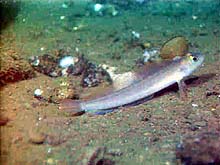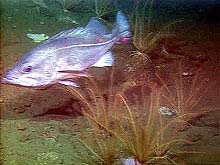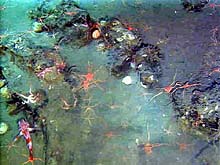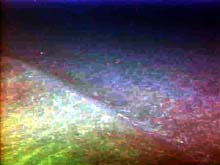
Pricklebacks are always seen perched in this posture. This may be one of several species that occur at this depth (127 m); they are hard to identify at the species level without holding them. Click image for larger view.

Bocaccio is the "poster child" for an overfished species. After 8 dive days on Heceta Bank, explorers have seen only five individuals on the bank. This one is estimated to be 80 cm in length. Click image for larger view.
An Unusual Carbonate Seep
July 11, 2001
Susan Merle, Geological Research Assistant
Cooperative Institute for Marine Resource Studies Program, Oregon State University
Vents Program, Pacific Marine Environmental Laboratory, NOAA
and
Curt Whitmire
Cooperative Institute for Marine Resource
Studies
Oregon State University
Another set of fish transects began around 11:20 am PDT on July 11. The remotely operated vehicle (ROV) ROPOS began Dive R615 southeast of the shallow portion of the southern bank. The course of this dive took us in a northwesterly direction over a zone of alternating high and low backscatter. The sea floor consisted mostly of mud, supporting some flatfish (mostly Dover sole) with scattered patches of boulders where greenstriped and rosethorn rockfish took refuge. Long, linear, almost continuous tracks in these mud plains were evidence of bottom trawling for commercially important species of groundfish. Samples collected on Dive R615 included two gorgonians (corals), two rocks with attached invertebrates, and two sand samples that may contain microscopic mollusks.
ROPOS surfaced around 4:39 pm to end Dive R615. At 7:53pm, the ROV returned to the water and headed to the bottom for nighttime Dive R616. The nightly geobiological survey began at the bottom of a steep slope area west of the shallow portion of the southern bank. ROPOS traversed up the slope, from a depth of approximately 690 m, over outcrops covered in brittlestars. Once at the top of the bank (200 m depth), ROPOS headed east toward the area believed to be an ancient beach. The path to the beach was a vast mud plain nearly devoid of macrofauna. On the way, the ship's sonar displayed an unusual linear feature that was producing a strong acoustic return. As the ROV approached this feature, we noticed low mounds of carbonate covered in small patches of whitish bacterial mat. ROPOS had found another seep area.

An unidentified species of brittlestar (bright red) scattered around the seafloor near a small rock outcrop on a mostly muddy substrate (660 meters of water). In the lower left is a longspine thornyhead. Click image for larger view.
Trawl tracks -- evidence of fishing activity on the southeast bank -- were observed on the muddy bottom during Dive R615. Click image for larger view.
The ROV cameras have illuminated many seep habitats throughout the cruise, but this one was quite different. There were no extensive beds of bivalves and gastropods; only rare, isolated shell fragments gave any indication of their past existence. Additionally, many fish, including sharpchin, rosethorn, and greenstriped rockfish, along with poachers, sculpins, and sole, were seen lying on the mud in the subtle valleys and crevices between the peculiar carbonate mounds. On the numerous video monitors, we noticed long, linear fractures in the carbonate structures filled with filamentous bacterial mat. ROPOS collected portions of this mat, as well as water and rocks, from the seep area. The latter part of the dive found ROPOS in the region of the supposed ancient beach. Here, the ROV collected sand, sediment, and shell samples.
Our final dive of the cruise (R617) began at 10:54 am PDT on July 12, and is focusing on a region southwest of historical station 1, near the shallow portion of the northern bank. This area consists of folded stratal ridges and troughs. Penetrating through these ridges at various orientations are a series of differentially eroded joint sets. These are some of the most interesting and c omplex geological features on the shallow portion of Heceta Bank. The ROV also located another seep habitat, where the cameras captured streams of bubbles rising upward that indicate gas emissions coming from below the gravel patches.
ROPOS is scheduled to remain in the water until we begin our transit into Newport, around 2 am on July 12.
Sign up for the Ocean Explorer E-mail Update List.






























